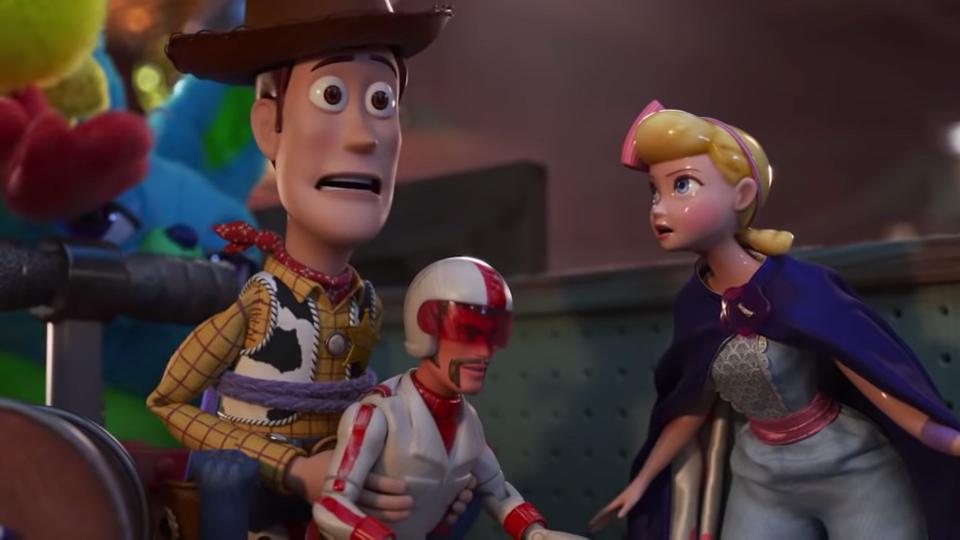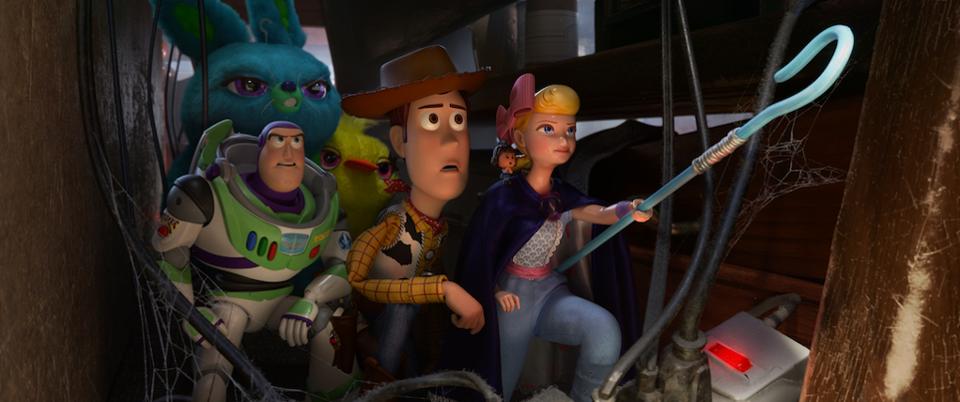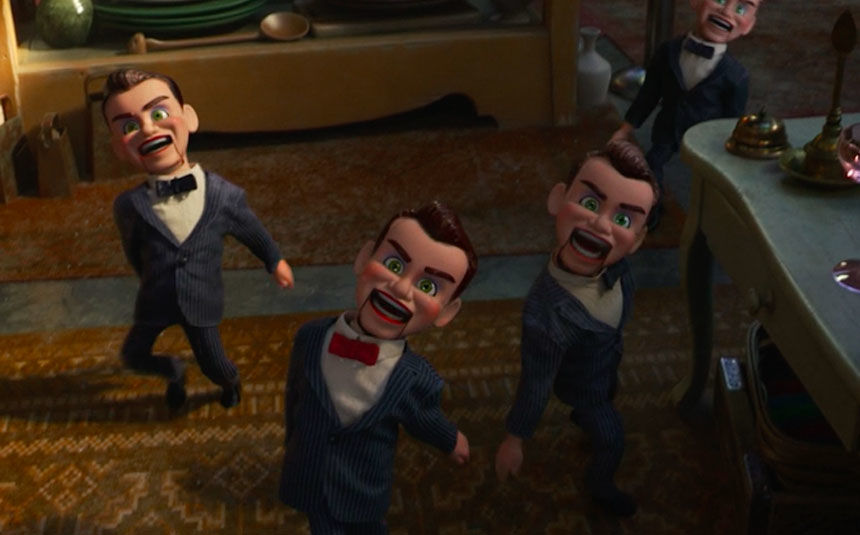
Toy Story 4 is a movie about fear, loneliness, pain, disillusionment, and loss. Your kids will love it.
You might too, if perhaps not quite as much as you adored its predecessors. It’s been 24 years since the computer wizards at Pixar released an 81-minute feature about playthings that leap to life when their owners leave the room, launching a mega brand and revolutionizing the concept of animation filmmaking in the process. Now the studio’s longest-running franchise (take that, Cars!), the Toy Story movies remain durable thanks to their nervy fusion of reliable adventure tropes and provocative philosophizing, the way they make you take stock of your life and yourself even as they place you back in touch with your inner child. In terms of raw entertainment, Toy Story 4 isn’t quite as boisterous as prior installments; the new director, Josh Cooley (one of the writers of the stupendous Inside Out), is certainly capable, but his set pieces lack the series’ trademark Rube Goldbergian complexity or eye-popping gusto. But the screenplay, by Andrew Stanton and Stephany Folsom, teems with ideas, challenges, and possibilities. The result is a movie that may not ascend beyond infinity, but at least gets most of the way there.
The usual artistic difficulty that vexes most extended franchises—how to deploy the same central characters to tell fresh and exciting new stories—is particularly acute for the Toy Story films, given their subjects’ essential agelessness. Toy Story 3 solved that problem with an audacious time jump; Andy, the toys’ imaginative and happy-go-lucky toddler, suddenly sprouted into a young adult with a limited interest in action figures, forcing his once-beloved companions to recalibrate their expectations. Wisely, Toy Story 4 doesn’t attempt to replicate the feat, instead picking up not long after that superior sequel left off, with our gang of heroes residing comfortably in the home of Bonnie, a sweet and temperate girl now set to enter kindergarten.

Of course, with the omnipresent threats of replacement and neglect looming with every advancing birthday, no one is ever truly comfortable in the Toy Story universe. Least of all Woody. Voiced as always with melancholy gravity by Tom Hanks, our favorite cowboy with a snake in his boot opens this movie out of favor, often tossed ignominiously in the closet while Bonnie plays with different, shinier toys. Woody’s fear of abandonment formed the main dramatic arc of the original Toy Story—what if Randy Newman’s “You’ve Got a Friend in Me” could apply to someone besides him?—but while he remains fretful and somewhat narcissistic, he insists, to himself as much as to his friends, that what really matters is Bonnie’s happiness, meaning he’ll take whatever steps necessary to safeguard it.
Does this remind you of anyone you know? Perhaps more than anything else, Toy Story 4 is a persuasive and heartfelt ode to the majesty and misery of parenting, which Woody practices with an undeniable helicopter slant. Is he devoted to Bonnie out of the goodness of his plastic heart, or out of a desperate need for purpose in his life, and the terror of being forgotten yet again? The script smartly lets the question hang there, causing the ambiguity to ripple out in waves of conflict and self-doubt. What we do know is that, much like Amy Poehler’s Joy in Inside Out, Woody is blessed with an unshakable confidence in the rightness of his opinions, which makes him both a noble nurturer of Bonnie’s welfare and also kind of the worst. His supremacy among his fellow toys may have waned over the years—naturally, Hamm (John Ratzenberger) and Mr. Potato Head (Don Rickles, who died in 2017 but whose lines have been seamlessly compiled from decades of archived sound) are keen to point out his diminished stature—but he still appoints himself Bonnie’s primary caretaker, which is why he secretly clambers into her backpack on her first day of school. And it is through this half-selfless, half-selfish gesture that Woody becomes deeply invested in protecting a spork.
Actually, his name is Forky, and he is not your average multi-purpose eating utensil. Fashioned by Bonnie from a handful of discarded art supplies, Forky (Tony Hale) is a spit-and-glue marvel, with googly eyes, blue rubber-band lips, red pipe-cleaner arms, and half-broken popsicle sticks for feet. Pixar is rightly renowned for its increasingly meticulous approach to computer animation, and that remains intact here; Cooley and his team have built a rich and elaborate world that sparkles with fine-grained detail and painterly polish. But that fastidiousness only makes Forky an even more appealing contradiction. In a universe of exquisite technological invention, he’s delightfully lo-fi.

He is also a total weirdo. Woody may be constantly tormented by the encroaching prospect of his uselessness as a toy, but Forky doesn’t even want to be a toy, instead craving to return to his beloved homeland—namely, the trash. This means that much of Toy Story 4 functions as a classically mismatched buddy comedy. Once Bonnie proclaims Forky her favorite new toy, Woody resolves to look after him on her behalf, even if it means stymieing his repeated attempts at suicide. This results in some amusing misadventures and misunderstandings, and though it grows exasperating on occasion, the dynamic between Woody and Forky bears thematic fruit; in essence, Woody has a new child to parent, and his weary patience allows Forky to attain a measure of enlightenment. Woody may be questioning the meaning of his own life, but that doesn’t prevent him from explaining a meaning of life—to be present for your kids, and to ease their pain however you can—to Forky.
Yet the more intriguing contrapuntal relationship—and the one that blossoms into the movie’s true heart—is that between Woody and Bo Peep (Annie Potts), the shepherd who was once one of Woody’s dearest companions until (as we see in the prologue) she was unceremoniously donated by Andy’s sister. While monitoring Forky during a family camping trip, Woody encounters Bo near an antique store, and the reunion is both joyous and fraught. Woody assumes that Bo will jump at the chance to rejoin her old friends, but she has embraced the life of the loner, helping unite lost toys with human families but refusing to assimilate into one herself. She is also something of a cynic; where Woody’s prime directive is to make his specific owner happy, Bo views people as capricious and indistinguishable. She also perceives—with, depending on your perspective, either clear or jaundiced eyes—that the connection between toys and humans is inherently ephemeral.
She might be onto something. The dark irony of the toys’ predicament is that they never age but are perpetually on the verge of becoming obsolete. Or, to invert Matthew McConaughey’s famous aphorism from Dazed and Confused: They stay the same age, the objects of their affection get older. Woody has always chosen to accept this burden with a kind of soldierly duty, but Bo’s newfound sanguinity presents him with a different path, one that isn’t destined to end in sadness. At the same time, his very identity is rooted in his paternalism; if he doesn’t have a child to care for, will he still be him?

This is a complex and cascading set of existential dilemmas, one that Toy Story 4 doesn’t explore quite as fully as it might have. Part of the reason may be that, despite Woody’s primacy, it’s still an ensemble picture, which means that it must make room for an assortment of characters, both old and new. Surprisingly, it’s the older ones who prove less interesting. Buzz Lightyear (Tim Allen) is still a spiffy space ranger, but his own saga of self-discovery resolved itself perfectly at the end of the first film, and his journey here—which involves him mistaking his pre-programmed, button-activated phrases for the voice of his actual conscience—isn’t as funny as it should be. And most of the other toys, including Hamm, Mr. Potato Head, dinosaur Rex (Wallace Shawn), and cowgirl Jessie (Joan Cusack), spend the majority of the movie cooped up in Bonnie’s RV, deprived of the opportunity to meaningfully participate in the action.
But maybe that’s OK, because the new arrivals pick up the slack. Inside the antique store, Woody encounters Gabby Gabby (Christina Hendricks), a chatty doll who takes peculiar notice of Woody’s old-school voice box; she’s flanked by an armada of ventriloquist dummies who, with their rosy cheeks, glassy eyes, and bobbing heads, are surely more terrifying than anything you might see in the new Child’s Play reboot. Separately, Buzz meets Bunny (Jordan Peele) and Ducky (Keegan-Michael Key), two adorably plush toys with a deceptively aggressive demeanor. (A tangent involving their patented “Plush Rush” maneuver seems silly until it becomes gratifyingly weird.) And the obvious highlight is Duke Caboom, a solemn Canadian daredevil who’s given voice with delirious enthusiasm by Keanu Reeves; that combination of actor and character is so instinctively wonderful, it requires no further embellishment. (Reeves provides plenty anyway, savoring the catchphrase, “Yes I Canada!”)
Cooley mashes these toys together with skill—an early montage of swooping match cuts is a glorious demonstration of the passage of time—but he doesn’t always know exactly what to do with them. There are some fun automotive sequences involving a mechanized craft masquerading as a skunk, and Bo’s trio of sheep deliver a steady supply of laughs. But while there are a number of funny throwaways—I particularly enjoyed the runner of a Combat Carl constantly seeking a high five—the dialogue isn’t as consistently hilarious as it was in the first (and still best) Toy Story. And though the animation is splendorous, the action never climbs to the dynamic heights reached in the sequels.
Which is hardly a damning assessment. One of the life lessons that Woody, Buzz, and the other toys have surely learned by now is that joy and disappointment are relative. So when I say that the ending of Toy Story 4 isn’t as devastating as the climax of Toy Story 3, what I really mean is that this time around, rather than being reduced to a quivering puddle of sobs, I merely felt tears streaming steadily down my face.
And the true genius of the Toy Story films, beyond their vast marketability, is the way that they continue to speak to us on a human level, no matter our age or disposition. Despite its occasional clumsiness, Toy Story 4 reinforces that commitment, that devotion. Like the best toys—and the best friends, and the best parents—these movies will always be there for us when they’re needed. Toy Story 4 reminds us, for one more thoroughly welcome time, that we’ve got a friend in them.
Grade: B
Jeremy Beck is the editor-in-chief of MovieManifesto. He watches more movies and television than he probably should.
